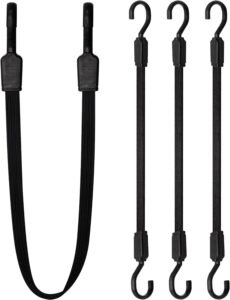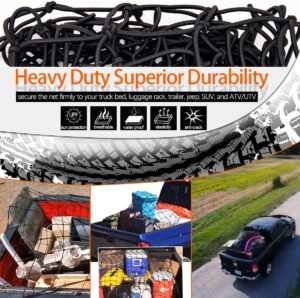If you’re a contractor or someone who frequently transports ladders, you may be wondering about the regulations or guidelines for securing ladders on a ladder rack. Safety is always a top concern when it comes to transporting equipment, and having a clear understanding of the rules can help ensure that you’re following best practices. In this article, we will explore whether there are any specific regulations or guidelines in place for securing ladders on a ladder rack, providing you with the information you need to keep your equipment safe and secure during transportation.
Overview of Ladder Racks
Definition
Ladder racks are sturdy structures that are specifically designed to securely hold ladders on vehicles during transportation. They are commonly used by professionals in various industries such as construction, utilities, telecommunication, and transportation to transport ladders safely and efficiently.
Types of Ladder Racks
There are several types of ladder racks available, each catering to different needs and vehicle configurations. Some common types include:
-
Side-mounted ladder racks: These racks are installed on the sides of the vehicle, allowing easy access to ladders and maximizing the use of available space.
-
Roof-mounted ladder racks: These racks are mounted on the roof of the vehicle, providing a convenient solution for carrying ladders while leaving the sides of the vehicle accessible for other purposes.
-
Hitch-mounted ladder racks: As the name suggests, these racks are attached to the hitch receiver of the vehicle, allowing for easy installation and removal.
-
Removable ladder racks: These racks can be easily installed or removed as needed, providing flexibility for vehicles that need to serve different purposes.
Importance of Securing Ladders on Ladder Racks
Securing ladders properly on ladder racks is of utmost importance to ensure the safety of both the vehicle occupants and those on the road. Improperly secured ladders can pose significant risks such as falling off the vehicle, causing accidents, injuries, or damage to property. Securing ladders on ladder racks not only prevents accidents but also extends the lifespan of the ladders by reducing the potential for damage during transit.
Regulations and Standards for Ladder Racks
Occupational Safety and Health Administration (OSHA) Standards
The Occupational Safety and Health Administration (OSHA) plays a crucial role in establishing and enforcing workplace safety regulations in the United States. While OSHA does not have specific regulations focusing solely on ladder racks, their general requirements for ladder safety apply to the use of ladder racks as well. Employers are responsible for ensuring a safe working environment and complying with OSHA’s guidelines relating to ladder use and transport.
American National Standards Institute (ANSI) Standards
The American National Standards Institute (ANSI) is a private, non-profit organization that develops voluntary consensus standards across various industries, including ladder rack safety. The ANSI standards specifically address ladder rack design, construction, and load capacity. Complying with ANSI standards helps ensure that ladder racks meet the necessary safety criteria and performance requirements.
Requirements for Securing Ladders on a Ladder Rack
Proper Positioning of Ladders
When loading ladders onto a ladder rack, it is essential to position them correctly to prevent any potential hazards. Ladders should be placed parallel to the ground, ensuring that they are aligned evenly on the rack. This proper positioning minimizes the risk of shifting or movement during transportation, maintaining stability and preventing damage.
Securing Methods
There are various methods to secure ladders on a ladder rack, including the use of tie-down straps, bungee cords, ropes, or specialized ladder rack systems. Regardless of the method chosen, it is crucial to ensure that the ladders are tightly secured and immobilized to prevent any movement or dislodging during transit.
Number of Ladders Allowed on a Rack
Each ladder rack has a specific load capacity that should not be exceeded. It is important to refer to the manufacturer’s guidelines and adhere to the recommended maximum number of ladders allowed on the rack. Overloading the ladder rack can lead to instability, compromising the safety of the vehicle and its occupants.
Inspection and Maintenance of Ladder Racks
Regular inspection and maintenance of ladder racks are essential to identify any potential issues or wear and tear. Employers should establish a detailed inspection schedule and ensure that any damaged or faulty components are replaced promptly. Regular maintenance helps to prolong the lifespan of the ladder rack and ensures its continued safety and functionality.
Specific Guidelines for Securing Ladders on a Ladder Rack
Using Ladder Tie-Down Straps
Ladder tie-down straps are specifically designed to securely fasten ladders onto ladder racks. These straps are typically made of high-quality nylon webbing with buckles or ratchets for easy tightening and release. When using ladder tie-down straps, ensure that they are mounted securely to the ladder rack and tightened adequately to prevent any movement during transportation.
Proper Weight Distribution
Evenly distributing the weight of the ladders on the ladder rack is vital for maintaining stability. Placing the heavier ladders closer to the vehicle and distributing the weight evenly across the rack helps prevent any unnecessary strain on the vehicle and reduces the risk of accidents caused by unbalanced weight distribution.
Securing Ladders with Bungee Cords or Ropes
In situations where ladder tie-down straps are not available, bungee cords or ropes can be used to secure ladders to the ladder rack. It is essential to securely fasten the cords or ropes, ensuring they are tightly stretched to minimize any potential movement or shifting of the ladders.
Securing Extensions and Telescopic Ladders
Extensions and telescopic ladders require special attention when being secured to a ladder rack. These types of ladders often have multiple sections that can slide in and out. To prevent any accidental extension or retraction during transportation, it is crucial to secure each section of the ladder individually using appropriate tie-down straps or other suitable securing methods.
Transportation Guidelines for Ladder Racks
When transporting ladders on a ladder rack, it is important to follow transportation guidelines specific to the industry and vehicle type. These guidelines may include adherence to speed limits, avoiding sudden maneuvers, and ensuring that the ladders do not obstruct the driver’s line of sight through the rearview mirror or side windows. By following these guidelines, the risk of accidents or damage caused by the ladders can be significantly reduced.
Best Practices for Securing Ladders on a Ladder Rack
Training and Awareness
Providing comprehensive training to employees regarding ladder rack safety is crucial for ensuring proper usage and securing techniques. Employees should be educated on the applicable regulations and instructed on the correct methods of securing ladders on ladder racks. Regular awareness campaigns can also help reinforce safe practices and promote a safety-conscious culture within the organization.
Regular Safety Audits
Conducting regular safety audits is essential to assess the effectiveness of ladder rack safety measures and identify any areas for improvement. These audits include inspections of the ladder racks, verification of proper securing methods, and evaluation of employee compliance with safety guidelines. By conducting regular safety audits, employers can proactively address any potential issues and improve safety protocols.
Providing Necessary Ladder Rack Accessories
Employers should ensure that employees have access to necessary ladder rack accessories, such as ladder tie-down straps, bungee cords, or ropes. Providing the appropriate accessories not only promotes safe securing practices but also demonstrates the employer’s commitment to providing a safe working environment. Having these accessories readily available encourages employees to secure ladders properly and minimizes the risk of using unsafe alternatives.
Using Safety Locks
To further enhance ladder rack safety, employing safety locks can be beneficial. These locks prevent the accidental disengagement of tie-down straps or other securing methods, ensuring that the ladders remain tightly fastened throughout the transportation process. Safety locks provide an additional layer of protection against potential incidents caused by insecurely fastened ladders.
Additional Considerations for Specific Ladder Types
Different ladder types may require special attention when securing them onto a ladder rack. For example, fiberglass ladders should be adequately protected from any sharp edges or abrasive surfaces to prevent damage during transit. Additionally, wooden ladders may require additional precautions to prevent moisture absorption, which can weaken the structural integrity of the ladder. Employers should provide specific guidelines and training for securing different ladder types to ensure their safe transportation.
Common Mistakes and Safety Risks
Overloading the Ladder Rack
One of the most common mistakes when securing ladders on a ladder rack is overloading. Exceeding the recommended load capacity can compromise the stability of the vehicle and lead to accidents. It is important to always refer to the manufacturer’s guidelines and ensure that the weight of the ladders does not exceed the capacity of the ladder rack.
Improper Securing of Ladders
Improperly secured ladders can shift or move during transportation, posing a significant safety risk. Neglecting proper securing methods, such as not tightening tie-down straps or ropes adequately, can result in ladders falling off the rack, potentially causing accidents, injuries, or damage to property. Employers should emphasize the importance of proper securing techniques and provide adequate training to minimize this risk.
Lack of Regular Inspection and Maintenance
Neglecting regular inspection and maintenance of ladder racks increases the chances of undetected damage or wear and tear. Failure to replace damaged components promptly or address any potential issues compromises the overall safety and integrity of the ladder rack. Employers should establish a regular inspection schedule and ensure that any necessary repairs or replacements are conducted promptly.
Inadequate Training and Awareness
Lack of training and awareness regarding ladder rack safety can lead to improper securing techniques or failure to adhere to safety guidelines. Employees should receive comprehensive training on ladder rack safety, including proper securing methods, weight distribution, and transportation guidelines. Emphasizing the importance of continuous training and awareness helps mitigate the risk of accidents caused by inadequate knowledge or disregard for safety protocols.
Consequences of Non-compliance
Workplace Accidents and Injuries
Non-compliance with ladder rack safety regulations can result in workplace accidents and injuries. Improperly secured ladders falling off a ladder rack can cause severe harm to employees or bystanders. Workplace accidents can also lead to increased healthcare costs, decreased productivity, and potential legal implications for the employer.
Legal Implications and Penalties
Non-compliance with ladder rack safety regulations may result in legal implications and penalties for employers. Failure to provide a safe working environment and adhere to applicable regulations can lead to fines, lawsuits, or even criminal charges. To minimize legal risks, employers should prioritize compliance with ladder rack safety standards and regulations.
Damage to Ladders and Equipment
Inadequate securing of ladders on a ladder rack can result in damage to the ladders themselves or other equipment being transported. Ladders falling off the rack can lead to dents, scratches, or even breakages. Not only does this impact the functionality and lifespan of the ladders, but it also incurs unnecessary repair or replacement costs.
Negative Impact on Business Reputation
Failure to comply with ladder rack safety regulations can have a negative impact on a business’s reputation. Accidents caused by improperly secured ladders can result in negative publicity, which may deter potential clients or customers. A strong commitment to safety, on the other hand, can enhance the reputation of a business and promote trust among stakeholders.
Industry-specific Regulations
Construction Industry Regulations
The construction industry has specific regulations governing ladder rack safety due to the nature of work involved. These regulations may include guidelines on load capacities, transportation requirements, and securing methods specific to construction-related ladders. Employers in the construction industry must be familiar with these regulations and ensure compliance to protect the safety of their workers and the general public.
Utilities and Telecommunication Industry Regulations
The utilities and telecommunication industries often require the use of specialized ladders, such as those suitable for working on electrical poles or communication towers. These industries typically have specific regulations outlining the requirements for ladder racks and securing methods appropriate for their unique ladder types. Employers in these industries should be well-versed in these regulations to ensure compliance and prevent accidents during transportation.
Transportation Industry Regulations
The transportation industry, including trucking and freight companies, also has industry-specific regulations regarding ladder rack safety. These regulations may focus on load securement, tie-down methods, and vehicle weight limits. Employers involved in the transportation of ladders must adhere to these regulations to maintain safety on the roads and prevent accidents caused by insecurely fastened ladders.
Resources and Tools for Compliance
OSHA and ANSI Websites
The Occupational Safety and Health Administration (OSHA) and the American National Standards Institute (ANSI) websites provide valuable resources and guidelines related to ladder rack safety. These websites offer access to OSHA’s general ladder safety standards and ANSI’s ladder rack design standards, allowing employers to stay updated on the latest regulations and best practices.
Safety Training Programs
Safety training programs focusing on ladder rack safety provide employees with the necessary knowledge and skills to secure ladders properly. These programs cover topics such as securing methods, weight distribution, inspection, and proper use of ladder rack accessories. Implementing safety training programs ensures that employees are well-equipped to meet compliance requirements and promote a culture of safety within the organization.
Ladder Rack Manufacturers’ Guidelines
Ladder rack manufacturers often provide detailed guidelines and instructions for securing ladders on their specific racks. These guidelines highlight the load capacities, securing methods, and maintenance requirements specific to their products. Employer compliance with these manufacturer guidelines not only ensures safety but also maintains warranty coverage for the ladder racks.
Professional Associations and Organizations
Various professional associations and organizations, such as the National Ladder Safety Month and the National Safety Council, offer resources and support for ladder rack safety compliance. These associations provide educational materials, webinars, and conferences that help employers stay updated on the latest regulations and share best practices. Joining such associations can be beneficial for employers constantly seeking to improve ladder rack safety within their organization.
Conclusion
Complying with ladder rack safety regulations and guidelines is essential for ensuring the safe transportation of ladders and reducing the risk of accidents or damage. Employers and employees share the responsibility of following proper securing methods, adhering to load capacities, and conducting regular inspections and maintenance. By implementing best practices, such as providing comprehensive training, conducting safety audits, and using appropriate ladder rack accessories, organizations can improve ladder rack safety and prevent workplace accidents. Continuous improvement in ladder rack safety should be a priority to create a safer working environment and protect the well-being of employees and the general public.







